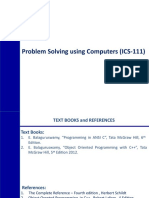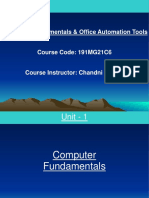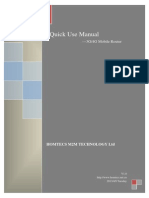CHAPTER 1– Computer Systems
(Suneetha L, KSPUC)
Chapter 1: Computer System
Introduction
Definition: Computers are electronic devices designed to accept input, process it, and
produce output.
Components: - CPU (Central Processing Unit): The brain of the computer responsible
for executing instructions. - Memory: Stores data and instructions temporarily or
permanently. - Input/Output Devices: Allow users to interact with the computer. -
Storage Devices: Provide long-term data storage.
Central Processing Unit
Components of a CPU
• CPU (Central Processing Unit): The brain of the computer responsible for
executing instructions.
• Memory: Stores data and instructions temporarily.
• Arithmetic & Logic Unit (ALU): Performs arithmetic and logic operations.
• Control Unit (CU): Controls the overall processes.
Input Devices
Definition: Devices that capture data and send it to the computer.
Examples: - Keyboard: Most common input device for text entry. - Mouse: Pointing
device for graphical interaction. - Scanner: Converts physical documents into digital
form. - Touch Screen: Allows direct interaction with the display.
Output Devices
Definition: Devices that convert digital data into a human-understandable form.
Examples: - Monitor: Displays visual output. - Printer: Produces physical copies of
digital documents. - Speaker: Outputs sound. - 3D Printer: Creates physical objects
from digital models.
Evolution of Computers
1. Abacus: Early counting tool.
2. Pascaline: Mechanical calculator by Blaise Pascal (1642).
1
�CHAPTER 1– Computer Systems
(Suneetha L, KSPUC)
3. Analytical Engine: Proposed by Charles Babbage, a mechanical generalpurpose
computer (1834).
4. Tabulating Machine: Designed by Herman Hollerith for summarizing data stored
on punched cards.
5. Turing Machine: A general-purpose programmable machine capable of solving
any problem by executing the program stored on punched cards.
6. EDVAC / ENIAC: Concept of stored program computers introduced by John Von
Neumann, capable of storing data and programs in memory.
7. Transistors: Replaced vacuum tubes, developed at Bell Labs using
semiconductor materials.
8. Integrated Circuits (ICs): Silicon chips containing entire electronic
circuits, drastically reducing computer size.
Computer Memory
Purpose: A computer system needs memory to store data and instructions for
processing. The secondary memory is used to store data, instructions, and results
permanently for future use.
Units of Memory
• Bit: 0 or 1
• Nibble: 4 bits
• Byte: 8 bits
Types of Memory
Primary Memory
• RAM (Random Access Memory): Volatile memory used for temporary data
storage.
• ROM (Read-Only Memory): Non-volatile memory used for permanent storage
of boot instructions.
• Cache Memory: High-speed memory located between the CPU and RAM to
speed up processing.
Secondary Memory
• Non-volatile storage for long-term data retention, including hard drives, SSDs,
CDs, and DVDs.
2
�CHAPTER 1– Computer Systems
(Suneetha L, KSPUC)
Data Transfer between Memory and CPU
System Bus: A communication system that transfers data between components inside
a computer. - Data Bus: Carries data. - Address Bus: Carries memory addresses. -
Control Bus: Carries control signals.
Steps in Data Transfer
1. Data Request: CPU requests data from secondary storage.
2. Transfer to Main Memory: Data is transferred from secondary storage to RAM.
3. Bus Utilization: Data transfer uses the system bus, including the data bus,
address bus, and control bus.
4. CPU Access: CPU accesses data from RAM for processing.
5. Data Storage: Processed data is either sent to output devices or stored
back in secondary storage.
Microprocessor & Microcontroller
• Microprocessor: An integrated circuit that performs the functions of a CPU.
• Microcontroller: A compact integrated circuit designed to govern a specific
operation in an embedded system, combining a CPU, memory, and input/output
peripherals.
Data & Information
• Data: Raw and unorganized facts.
• Information: Processed data.
Types of Data
• Structured Data: Organized in fixed formats (e.g., databases).
• Semi-Structured Data: Partially organized but not fixed (e.g., email metadata,
HTML documents).
• Unstructured Data: No predefined structure (e.g., text, images).
Data Capturing, Storage, & Retrieval
• Capturing: Gathering data from different sources in digital form.
• Storage: Storing captured data for processing later.
3
�CHAPTER 1– Computer Systems
(Suneetha L, KSPUC)
• Retrieval: Fetching the data from storage devices.
Software
Definition: Software comprises a set of instructions which, on execution, deliver the
desired outcome.
Need for Software
We cannot instruct the hardware of a computer directly. Software acts as an interface
between human users and the hardware.
Types of Software • System Software • Programming Tools • Application Software
System Software
• Operating System: Manages hardware resources and provides common services
for application software.
• Utilities: System management tools.
• Device Drivers: Control the hardware components.
Programming Tools
• Compilers: Convert high-level language code into machine code in a single
batch.
• Interpreters: Convert and execute high-level language code line-by-line.
• Assemblers: Convert assembly language into machine code.
Application Software
• General Purpose Software: Application software developed for generic
applications to cater to a bigger audience.
• Customized Software: Tailor-made application software developed to
meet the requirements of a specific organization or individual.
Proprietary / Free / Open Source Software
• Proprietary Software: Must be purchased from the vendor who has the
copyright.
• Free Software: Freely available for use but source code may not be available.
• Open Source Software: Developers provide their source code and soft-
ware freely to the public to develop and improve further collaboratively.
4
�CHAPTER 1– Computer Systems
(Suneetha L, KSPUC)
Operating Systems
Definition: System software that manages hardware resources and provides common
services for application software.
OS User Interface
• Command-Line Interface (CLI): Allows users to interact with the computer using
text commands.
• Graphical User Interface (GUI): Uses visual elements like windows, icons, and
menus for interaction.
• Touch Interface: Enables interaction through touch gestures.
• Voice Interface: Allows interaction using voice commands.
• Gesture Interface: Uses physical gestures for interaction.
Functions of OS
• Process Management: Handles the execution of multiple processes.
• Memory Management: Allocates memory to processes and manages memory
usage.
• File Management: Organizes and manages data storage.
• Device Management: Controls and coordinates hardware devices.























































































